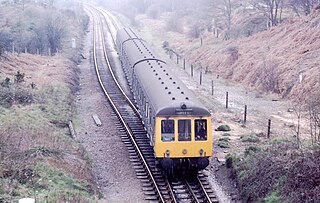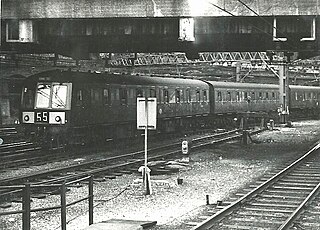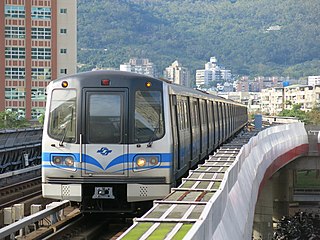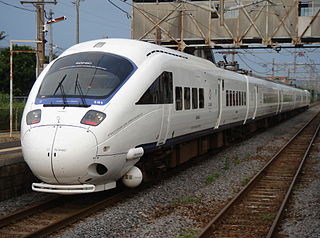
A diesel multiple unit or DMU is a multiple-unit train powered by on-board diesel engines. A DMU requires no separate locomotive, as the engines are incorporated into one or more of the carriages. Diesel-powered single-unit railcars are also generally classed as DMUs. Diesel-powered units may be further classified by their transmission type: diesel–mechanical DMMU, diesel–hydraulic DHMU, or diesel–electric DEMU.

Taiwan Railways Administration (TRA) was a governmental agency in Taiwan which operated Taiwan Railway from 1948 to 2023. It managed, maintained, and operated conventional passenger and freight railway services on 1,097 km (682 mi) of track. Passenger traffic in 2018 was 231,267,955.

The British Rail Class 116 diesel multiple units were built by BR Derby from 1957 to 1961. Introduced as part of the British Railways Modernisation Plan in the mid 1950s, as with other first generation DMUs the 116 was intended to replace steam trains and reduce costs across the rail network. Alongside Metro-Cammell, BR Derby had prior experience with DMUs, having developed a Lightweight Unit, and so was awarded a contract for a new design.

The British Rail Class 127 diesel multiple units were built by BR Derby in 1959. Thirty 4-car units were built, formed of two outer driving motor vehicles, sandwiching two intermediate trailers which were classified class 186. The technical description of such as 4-car unit was DMBS + TSL + TS + DMBS.

Hyundai Rotem is a South Korean company that manufactures rolling stock, defense products and plant equipment. It is a part of the Hyundai Motor Group. Its name was changed from Rotem to Hyundai Rotem in December 2007 to reflect the parent company. It is also called Hyundai Railroad Technology Systems.

The Taitung Line, also known as the Hua-Tung line, is the southern section of the Eastern Line of the Taiwan Railways Administration. The line starts at the Hualien station and ends at the Taitung station. It is 161.5 km long, including the main segment of 155.7 km between Hualien and Taitung.

The Budd Rail Diesel Car (RDC), also known as the Budd car or Buddliner, is a self-propelled diesel multiple unit (DMU) railcar. Between 1949 and 1962, 398 RDCs were built by the Budd Company of Philadelphia, Pennsylvania, United States. The cars were primarily adopted for passenger service in rural areas with low traffic density or in short-haul commuter service, and were less expensive to operate in this context than a traditional diesel locomotive-drawn train with coaches. The cars could be used singly or coupled together in train sets and controlled from the cab of the front unit. The RDC was one of the few DMU trains to achieve commercial success in North America. RDC trains were an early example of self-contained diesel multiple unit trains, an arrangement now in common use by railways all over the world.

Japan Transport Engineering Company (J-TREC) is a manufacturer of heavy rail cars in Japan, formerly known as Tokyu Car Corporation. The company is based in Kanazawa-ku, Yokohama, and a member of East Japan Railway Company group. J-TREC manufactures rail vehicles not only for JR East and Tokyu Corporation but for other Japanese operators, including various Japan Railways Group companies and international operators as well.

The British Rail Class 125 was a design of three car Diesel Multiple Unit built by BR Derby at Derby Works in 1958. They were almost identical in appearance to the Class 116.

The Kawasaki Railcar Manufacturing Company is the Japanese rolling stock manufacturing subsidiary of Kawasaki Heavy Industries. Since beginning operations in 1906, the company has produced more than 90,000 railroad cars.
The railways of New South Wales, Australia, use a large variety of passenger and freight rolling stock. The first railway in Sydney was opened in 1855 between Sydney and Granville, now a suburb of Sydney but then a major agricultural centre. The railway formed the basis of the New South Wales Government Railways. Passenger and freight services were operated from the beginning. By 1880, there was a half hourly service to Homebush.

The Ministry of Transportation and Communications governs transportation in Taiwan.
Tze-Chiang, also Tzu-chiang or Ziqiang, is a type of limited express train service operated by Taiwan Railway (TR). Of the five service classes operated by TR, the Tze-Chiang service is the fastest. Ticketing is done on the basis of mileage.

The Hitachi A-train is a family of rail rolling stock built and designed by Hitachi Rail using a common base and construction techniques. The stock is designed to facilitate a number of product life-cycle improvements including ease of manufacture, increased energy efficiency, and recyclability.

The Taiwan Railway EMU100 series was a set of rail cars fabricated by British Rail Engineering Limited and the General Electric Company in 1976 that has operated in Taiwan. The alternating current electric multiple unit (EMU) fleet entered full squadron service in 1979, and was withdrawn from service in 2009. This class of railcars were the first to operate on the electric Tzu-Chiang Express. Due to the unit's British origin, rail buffs have variously nicknamed them "British Girl", "British Lady", or "British Grandma".

The Puyuma Express is a type of railway service on Taiwan Railway (TR) notable for using tilting trains. It began commercial service on 6 February 2013 during the Spring Festival.

Taiwan Railway (TR) is a state-owned conventional railway in Taiwan. It is operated by the Taiwan Railway Corporation under the supervision of the Ministry of Transportation and Communications, responsible for managing, maintaining, and running conventional passenger and freight railway services on 1,097 km (682 mi) of track in Taiwan. Passenger traffic in 2018 was 231,267,955.

Taiwan Rolling Stock Company (TRSC) is a rail vehicle company. TRSC is located in Hukou, Hsinchu County, near Xinfeng railway station. It was previously a rolling stock production division of Tang Eng Iron Works before 2002. After privatization, the company received several orders from Taiwan Railways Administration and also Kawasaki Heavy Industries. For example, some vehicles of the Taipei Metro system were built by TRSC.

The DR2800 series is a series of diesel multiple unit trains operated by the Taiwan Railways Administration as Tze-chiang limited express on non-electrified mainlines. They were originally built by Tokyu Car Corporation of Japan in 1982 for the Taiwan Railways Administration to provide better service on the eastern mainline of Taiwan.

The DR2900 series and DR3000 series is two series of diesel multiple unit trains operated by the Taiwan Railways Administration as Tze-chiang limited express on non-electrified mainlines. They were originally built by Hitachi in 1986(DR2900) and 1990(DR3000) for the Taiwan Railways Administration to provide more service on the eastern mainline of Taiwan. Although two trains are named with different numbers, they actually shared the same design.





















